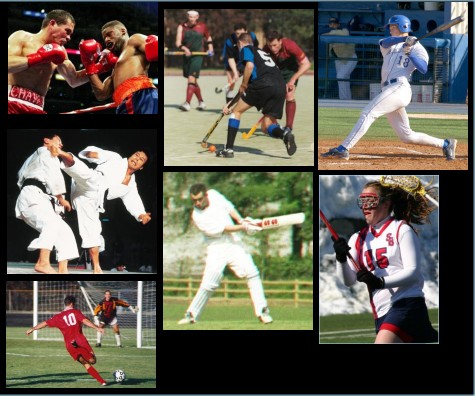Commotio cordis primary prevention: Difference between revisions
No edit summary |
|||
| Line 7: | Line 7: | ||
[[Image:Sports-dress-codes.jpg|thumb|left|300px|Equipment and dress used in several sports. clearly demonstrating the lack of protection against chest concussion. From left to right, top to bottom: boxing, field hockey, baseball, karate, cricket, lacrosse and soccer.]] The mandatory use of heavily padded special vests in front of the thorax is generally sufficient to prevent high energy impacts to the precordium. The problem with many sports such as soccer, baseball and karate is that, despite the danger posed by a multitude of punches, kicks, pads, mallets, bats, pucks and balls moving at high speeds, etc., their dress codes represent an obstacle to the use of mechanical protection to the precordium for all players, or at least for goalkeepers, batters, ball catchers, etc. | [[Image:Sports-dress-codes.jpg|thumb|left|300px|Equipment and dress used in several sports. clearly demonstrating the lack of protection against chest concussion. From left to right, top to bottom: boxing, field hockey, baseball, karate, cricket, lacrosse and soccer.]] The mandatory use of heavily padded special vests in front of the thorax is generally sufficient to prevent high energy impacts to the precordium. The problem with many sports such as soccer, baseball and karate is that, despite the danger posed by a multitude of punches, kicks, pads, mallets, bats, pucks and balls moving at high speeds, etc., their dress codes represent an obstacle to the use of mechanical protection to the precordium for all players, or at least for goalkeepers, batters, ball catchers, etc. | ||
For example, boxing traditionally requires a naked chest, cricket gear protects the legs but not the chest, and soccer has practically no protection gear at all; although the ball | For example, boxing traditionally requires a naked chest, cricket gear protects the legs but not the chest, and soccer has practically no protection gear at all; although the ball weighs 450 grams, may reach speeds of 30 meters per second, and barrier defenses actually encourage the reception of the ball against the chest. | ||
Parents of children active in these sports are advised to adopt simple protective measures, particularly in informal "backyard" games, which are often much more dangerous than formal ones, which require some protection. | Parents of children active in these sports are advised to adopt simple protective measures, particularly in informal "backyard" games, which are often much more dangerous than formal ones, which require some protection. | ||
According to data from the Commotio Cordis Registry, chest guards and safety baseballs are not a guarantee against commotio cordis. In 37% of commotio cordis incidents in competitive sports, chest protection was used. Again, it is impossible to evaluate these results in terms of danger without knowing the proportional frequency of impacts with or without chest protection. It is obvious that commotio cordis cannot be completely avoided, even with chest protection <ref name="pmid266216532">{{cite journal| author=Link MS, Estes NA, Maron BJ, American Heart Association Electrocardiography and Arrhythmias Committee of Council on Clinical Cardiology, Council on Cardiovascular Disease in Young, Council on Cardiovascular and Stroke Nursing, Council on Functional Genomics and Translational Biology, and American College of Cardiology| title=Eligibility and Disqualification Recommendations for Competitive Athletes With Cardiovascular Abnormalities: Task Force 13: Commotio Cordis: A Scientific Statement From the American Heart Association and American College of Cardiology. | journal=Circulation | year= 2015 | volume= 132 | issue= 22 | pages= e339-42 | pmid=26621653 | doi=10.1161/CIR.0000000000000249 | pmc= | url=https://www.ncbi.nlm.nih.gov/entrez/eutils/elink.fcgi?dbfrom=pubmed&tool=sumsearch.org/cite&retmode=ref&cmd=prlinks&id=26621653 }}</ref> | |||
==References== | ==References== | ||
{{reflist|2}} | {{reflist|2}} | ||
Revision as of 23:42, 11 January 2023
|
Commotio cordis Microchapters |
|
Diagnosis |
|---|
|
Treatment |
|
Case Studies |
|
Commotio cordis primary prevention On the Web |
|
American Roentgen Ray Society Images of Commotio cordis primary prevention |
|
Risk calculators and risk factors for Commotio cordis primary prevention |
Editor-In-Chief: C. Michael Gibson, M.S., M.D. [1]
Please help WikiDoc by adding more content here. It's easy! Click here to learn about editing.
Primary Prevention

The mandatory use of heavily padded special vests in front of the thorax is generally sufficient to prevent high energy impacts to the precordium. The problem with many sports such as soccer, baseball and karate is that, despite the danger posed by a multitude of punches, kicks, pads, mallets, bats, pucks and balls moving at high speeds, etc., their dress codes represent an obstacle to the use of mechanical protection to the precordium for all players, or at least for goalkeepers, batters, ball catchers, etc.
For example, boxing traditionally requires a naked chest, cricket gear protects the legs but not the chest, and soccer has practically no protection gear at all; although the ball weighs 450 grams, may reach speeds of 30 meters per second, and barrier defenses actually encourage the reception of the ball against the chest.
Parents of children active in these sports are advised to adopt simple protective measures, particularly in informal "backyard" games, which are often much more dangerous than formal ones, which require some protection.
According to data from the Commotio Cordis Registry, chest guards and safety baseballs are not a guarantee against commotio cordis. In 37% of commotio cordis incidents in competitive sports, chest protection was used. Again, it is impossible to evaluate these results in terms of danger without knowing the proportional frequency of impacts with or without chest protection. It is obvious that commotio cordis cannot be completely avoided, even with chest protection [1]
References
- ↑ Link MS, Estes NA, Maron BJ, American Heart Association Electrocardiography and Arrhythmias Committee of Council on Clinical Cardiology, Council on Cardiovascular Disease in Young, Council on Cardiovascular and Stroke Nursing, Council on Functional Genomics and Translational Biology, and American College of Cardiology (2015). "Eligibility and Disqualification Recommendations for Competitive Athletes With Cardiovascular Abnormalities: Task Force 13: Commotio Cordis: A Scientific Statement From the American Heart Association and American College of Cardiology". Circulation. 132 (22): e339–42. doi:10.1161/CIR.0000000000000249. PMID 26621653.